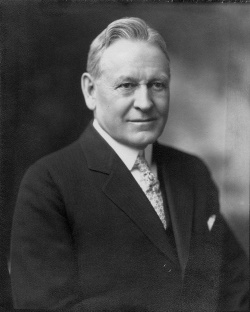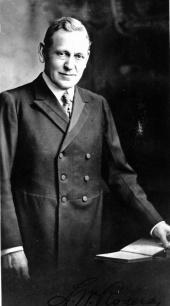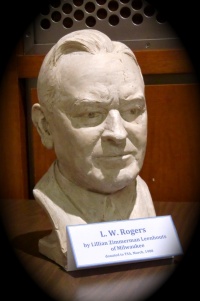L. W. Rogers
Louis William Rogers was an American lecturer and editor who served from 1920 to 1931 as General Secretary and President of the American Theosophical Society in the Theosophical Society based in Adyar. He was a man of great energy and vision, who organized dozens of lodges in the United States.
Early life
Louis William Rogers was born in the Midwestern state of Iowa on May 28, 1859. He taught in the public schools of Iowa and Kansas for five years, beginning late in the 1870s.[1] In the 1880s Rogers became a public lecturer in the Free Thought movement, which had Rationalism as its underlying philosophy.
Railroad career and union activities
Rogers began a railroad career with a job as a brakeman, and went on to edit a series of periodicals related to railroads and their unions. In 1888 Rogers launched a short-lived newspaper, the Railroad Patriot of St. Joseph, Missouri.[1] The next year, he moved to Colorado, where he became active first in the Brotherhood of Railroad Brakemen and then in the Brotherhood of Railroad Trainmen.[1] From 1889 to 1892 he edited several periodicals - the Railroad Brakemen's Journal, the Denver Patriot, and the Vona Herald. Early in the 1890s Rogers returned to the Midwest, moving first to the rail hub of Galesburg, Illinois, then to Chicago, and finally in 1892 to Oshkosh, Wisconsin. He published a new paper, the Age of Labor, which merged in 1893 with The Labor Advocate, a prominent labor newspaper of the day.[1] That year he helped to establish the Wisconsin Federation of Labor.[1]
American Railway Union activities
In 1894, former Brotherhood of Locomotive Firemen official Eugene V. Debs established the American Railway Union (ARU), attempting to create an industrial union that joined all the railway workers in a powerful, centralized organization. Rogers became a member of the ARU's executive board, and was appointed editor of the organization's weekly newspaper, Railway Times.[1] In 1894, the United States Attorney General responded to the ARU's famous Pullman Strike by issuing an injunction ordering the union to cease striking against any train carrying U.S. Mail.[2] L. W. Rogers, Eugene V. Debs, and two other union officials were found to be in contempt of the injunction, and they surrendered to authorities on July 17, 1894. Bail was set at $3,000 each, and all four ARU officials waived the right to post bail. They were immediately taken to Cook County Jail. Rogers later recalled that the substantial amount set for bail was not the cause of the decision to waive bail, declaring, "If it was $2, I'd go to jail. This is a mighty test between labor and capital, and we will fight it to the finish."[3] The four were released on July 25.[4] After a trial, the union and its leaders were found guilty of having conducted an illegal strike in violation of the Sherman Anti-Trust Act.[5] Rogers was sentenced to three months to be served in McHenry County Jail, which was served from June to August, 1895.[6] Debs and the union were subjected to further charges in a case that was defended all the way to the U. S. Supreme Court by the famous orator Clarence Darrow, although the unionists ultimately lost.
Later union activism
Rogers moved to Pueblo, Colorado, where he worked as an organizer for the American Federation of Labor, and edited another labor newspaper in 1896, the Industrial Advocate.[1] In 1897 he returned to Chicago to edit The Social Democrat, the journal of Eugene V. Debs' new politicl party, the Social Democratic Party of America. He also helped to organize Debs' lecture tours for two years.[1] He remained involved with the labor movement, serving as President of the Michigan Federation of Labor from 1898 to 1899.[1]
Theosophical Society activities
In the 20th Century, Rogers' attention turned to spirituality, after Eugene V. Debs gave him a book about reincarnation.[7]. In 1903 Rogers joined the American Theosophical Society.[8] He threw himself whole-heartedly into the Theosophical movement, lecturing extensively and publishing numerous books, articles, and pamphlets on reincarnation, life after death, karma, and dreams, and other matters. A firebrand speaker, Rogers was much in demand as a lecturer. Within fifteen years he had organized 53 new lodges.[9]
From April, 1908 to October, 1909 he edited a periodical with the name American Theosophist, published in Albany, New York.
Mr. Rogers’ granddaughter, Virginia Roach, commented on his strong friendship with Manly Hall, in an interview conducted by Robert and Leatrice Bonnell: “They were the closest of friends and spent many evenings exchanging views of lecturing locations pointed out on a world map spread before them. She also recalled the many Hall lectures, which L. W. enthusiastically attended.”[10]
Theosophical Society activities of Rogers family
May Rogers accompanied her husband on many of his lecture tours. After L. W. had stirred up interest in a new location with his rousing public lectures, May would teach a beginning class in Theosophy for two weeks, so that a new lodge could be left well-established. May also served for a time as secretary to Annie Besant.
Sons Grayson and Stanley were also involved with the Society. In 1926 George S. Arundale, then General Secretary of the Australian Section, wrote that "We are indeed blessed with Mr. Stanley Rogers, a printing expert, the son of the American General Secretary and of Mrs. Rogers. What we should do without him I do not know."[11]
Vice President and Acting President
He was elected Vice President in 1918 during the administration of A. P. Warrington.
1920 Convention
On March 18, 1920, A. P. Warrington addressed a letter to the Trustees of the Section, announcing his resignation.[12] Ultimately, Rogers was elected as President (General Secretary) of the Section.
President of the American Theosophical Society
His first actions as President were decisive. Within a month, he changed the venue for the Thirty-Fourth Annual Convention from Seattle to Chicago. The National Secretary, Foster Bailey, was replaced by Mrs. Betsey Jewett. At the same time, Rogers removed the editor of the Society's periodical, The Messenger, Alice Evans, who later became Alice Bailey. Mrs. Grace Boughton Voce became Editor. Woodruff Sheppard, the Publicity Director, was removed from his position, and Bruno Ussher temporarily took over.[13]
In May he published a statement of policy that he had promised to the membership. While the American Theosophical Society was sound financially, its affairs were complicated by the economic disarray of the Krotona Institute of Theosophy. Ultimately the property in Hollywood was sold. The Esoteric Section moved to Ojai, California, and Rogers moved headquarters operations back to Chicago, which he considered to be more suitable due to its central location. The Theosophical Book Concern was re-established to increase publication and distribution of Theosophical books. His plan was to emphasize publishing as a major activity of the national organization, and to strengthen the local groups with national lecturers. In 1920 alone, he opened 55 branches of the Society. A tireless organizer, he continually lectured all over the country.
By 1925, the headquarters location in Chicago had become very overcrowded, and an initiative was undertaken to find a new permanent location. Rogers and his board wanted to stay in a central location within 500 miles of Chicago, and to create a campus where administrative activities could be conducted along with educational events and retreats. The National Secretary Kay Campbell found suitable land in Wheaton, Illinois that eventually became known as the Olcott campus. Members donated and loaned money so that the headquarters building could be built, and operations were moved into it in September 1927. The headquarters structure was eventually renamed the L. W. Rogers Building in honor of the President who made it happen.
Among the other accomplishments of the Rogers administration are these:[14]
- Increasing membership from 3,000 to over 8,000 members.
- Increasing the number of lodges from 100 to 209.
- Founding the Theosophical Book Gift Institute.
- Revising the national by-laws to a more democratic platform
- Founding the Messenger newsletter.
Later years
Sidney A. Cook took over as president in 1931. During the years after his presidency, Mr. Rogers continued to lecture around the country on behalf of the Society. In 1931 Mr. Rogers reported that 48 new members joined the St. Louis Lodge after a week of lectures, and regarded that as "the largest number ever obtained during a single week by one Lodge in his entire experience of 28 years."[15] Another spectacular success in his later years of lecturing came when he toured Mexico in 1939: "Inspired by the leadership of Mr. L. W. Rogers, thirty-eight members in Mexico city have joined hands in a new lodge for the spreading of Theosophy in Mexico. Mr. Rogers writes that thirty-six of these members are entirely new to the Society."[16]
In 194_ he announced his retirement from the lecture circuit, and undertook expansion of the Theosophical Book Gift Institute.
Louis Rogers died in Santa Barbara, California, on April 18, 1953.[17]
Editorial work
UNDER CONSTRUCTION
Rogers served as the editor of two of the Society's other periodicals — Ancient Wisdom, which he edited from 1935 to 1936, and The Voice, from 1951 to 1952.
Writings about Theosophy
Mr. Rogers wrote hundreds of columns and articles for The Messenger, The Theosophic Messenger, The American Theosophist, The Theosophist, Discovery, and other periodicals. They are listed in the Union Index of Theosophical Periodicals under the names "LW Rogers", "L W Rogers", and LWR. In 1949, Mr. Rogers was awarded the Subba Row Medal for his contributions to Theosophical literature.
These are some of his numerous books and pamphlets, listed in order of publication:
- The Evidence for Theosophy: A Lecture. Harrogate: Theosophical Publishing Committee, 1906.
- The Occultism in Shakespeare's Plays. New York: Theosophical Book Co., 1909. Available at Internet Archive and Hathitrust.
- Occultism as a Factor in Civilization: A Lecture on the Two Phases of Human Evolution Represented in the Civilization of the Occident and the Orient. Ridgewood, NJ: Theosophical Book Company, 1910.
- The Hidden Side of Evolution: A Lecture on the Reasonableness of the Existence of a Spiritual Hierarchy and the Guidance of Human Evolution. Chicago: L.W. Rogers, n.d. [c. 1910s].
- What Theosophy Is. Chicago: National Publicity Department, Theosophical Society, 1910.
- Soul Powers and Possibilities: A Lecture on Some of the Methods of Nature in Evolving Latent Powers and Faculties in Human Beings. Los Angeles: Theosophical Book Concern, 1910.
- Karma: Nature's Law of Justice: A Lecture on the Law of Cause and Effect as Operating in Some of the Affairs of Love. Los Angeles: Theosophical Book Concern, n.d. [c. 1910s].
- Hints to Young Students of Occultism.
- 3rd Edition - Ridgewood, N.J.: The Theosophical Book Co., 1911. Available at Hathitrust.
- 4th Edition - Los Angeles: Theosophical Book Concern, 1917. Available at [Available at Hathitrust and another Hathitrust version.
- Chicago: Theosophical Theosophical Concern, 1931.
- The Inspired Life. Los Angeles: L.W. Rogers, 1915.
- Self Development and the Way to Power. Los Angeles: L.W. Rogers, 1916. Available at Overdrive Content Reserve and Hathitrust.
- Elementary Theosophy. Los Angeles: Theosophical Book Concern, 1917. Seven more edition by Theosophical Press and Theosophical Publishing House, Wheaton, Illinois. 1917 edition available online at Internet Archive and Hathitrust.
- The Life Sublime. Chicago: Theosophical Book Concern, 1917.
- Reincarnation from the Scientific Viewpoint: A Lecture Chicago: Theosophical Book Concern, 1917.
- Reincarnation: Do We Live on Earth Again? Chicago: National Publicity Dept., Theosophical Society, 1917.
- The Logic of Reincarnation: A Lecture. Chicago: Theosophical Book Co., 1918.
- Beyond the Border: A Lecture. Chicago: Theosophical Book Co., 1918.
- Occultism as a Factor in Civilization: A Lecture. Chicago: Theosophical Book Concern, 1918.
- Scientific Evidence of Future Life: A Lecture. Chicago: Theosophical Book Concern, 1918.
- The Invisible World About Us: A Lecture on the Unseen Regions Beyond the Grasp of the Physical Senses and the Life We Live After Bodily Death. Chicago: Theosophical Book Concern, 1918. Available at Hathitrust.
- Australian War Speeches and the Soldier Dead. Chicago: Theosophical Book Concern, c. 1918.
- Dreams and Premonitions. Chicago: Theosophical Book Concern, 1923 and Wheaton, Ill.: The Theosophical Press, 1948.
- Theosophical Questions Answered. Chicago: Theosophical Book Concern, 1924.
- Gods in the Making, and Other Lectures. Chicago: Theosophical Book Concern, 1925. Republished in 1950 as Man: An Embryo God, and Other Lectures.
- The Purpose of Life, and Other Lectures. Chicago: Theosophical Book Concern, 1925.
- The Soldier Dead; and A Scientific Religion. Chicago: Theosophical Book Concern, 1925.
- Universal Brotherhood. Chicago: Theosophical Concern, 1925.
- The Coming Civilization. Chicago: Theosophical Book Concern, 1934.
- Olcott Manual: First Series: Theosophy, Religion, Science, Philosophy. With Annie Besant. Wheaton, IL: Theosophical Press, 1934.
- Reincarnation, and Other Lectures. Wheaton, IL: Theosophical Press, n.d. [1940s].
- The Ghosts in Shakespeare: A Study of the Occultism in the Shakespeare Plays. Wheaton, IL: Theosophical Press, 1949 and 1955; New York, Haskell House Publishers, 1972; and Folcroft, Pa.: Folcroft Library Editions, 1973. First edition was in 1925.
- Man: An Embryo God, and Other Lectures. Wheaton, IL: Theosophical Press, 1950. Published in 1925 as Gods in the Making.
- Karma: The Law of Human Destiny. New York: Philosophers Book Shop, n.d.
- A World in Distress: the Remedy as Seen by the Theosophist coauthored by C. Jinarājadāsa and Charles Leadbeater.
Online resources
Articles
- Memories of L. W. Rogers by Robert Bonnell and Leatrice Kreeger-Bonnell.
Notes
- ↑ 1.0 1.1 1.2 1.3 1.4 1.5 1.6 1.7 1.8 Stuart B. Kaufman, Peter J. Albert, and Grace Palladino (eds.), The Samuel Gompers Papers: Volume 4: A National Labor Movement Takes Shape, 1895-98, (Urbana, IL: Illinois University Press, 1991), 547-548.
- ↑ David Ray Papke, The Pullman Case: The Clash of Labor and Capital in Industrial America., (Lawrence, KS: University Press of Kansas, 1999), 40.
- ↑ Quoted in Papke, The Pullman Case, 44.
- ↑ J. Robert Constantine (ed.), Letters of Eugene V. Debs: Volume 1, 1874-1912, (Urbana, IL: Illinois University Press, 1990), 72.
- ↑ Papke, The Pullman Case, pp. 49-50.
- ↑ Constantine (ed.), Letters of Eugene V. Debs: Vol. 1, pg. 98, fn. 9.
- ↑ Joy Mills, 100 Years of Theosophy in America, Wheaton, Ill.: Theosophical Publishing House, 1987), 68.
- ↑ Robert Bonnell and Leatrice Kreeger-Bonnell, Quest, 92:6 (Nov.-Dec. 2004), 224-226. Available at "Memories of L.W. Rogers,".
- ↑ ""About the Candidates: L. W. Rogers," The American Theosophist" 33.4 (April, 1945), 86.
- ↑ Robert Bonnell and Leatrice Kreeger-Bonnell, "Memories of L. W. Rogers" The Quest 92.6 (November-December 2004), 224-226. Available at Quest website.
- ↑ "News Items" The Messenger14.3 (August 1926), 65.
- ↑ The Messenger (April, 1920) ????????
- ↑ Mills, 68-69.
- ↑ Robert Bonnell and Leatrice Kreeger-Bonnell, "Memories of L. W. Rogers" The Quest 92.6 (November-December 2004), 224-226. Available at Quest website.
- ↑ "What Lodges Are Doing" The Theosophical Messenger 19.5 (May, 1931), 402.
- ↑ "New Lodge In Mexico, " The American Theosophist 27. 10 (October, 1939), 239.
- ↑ State of California. California Death Index, 1940-1997. Sacramento, CA, USA: State of California Department of Health Services, Center for Health Statistics. Accessed through www.ancestry.com. California, Death Index, 1940-1997 [database on-line]. Provo, UT,USA: Ancestry.com Operations Inc, 2000.



